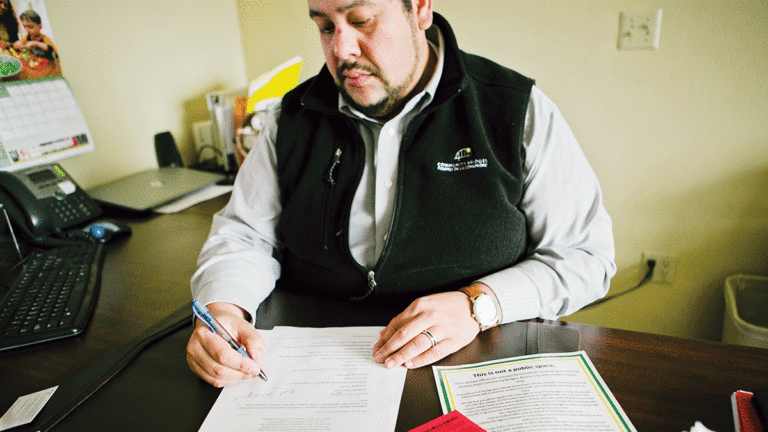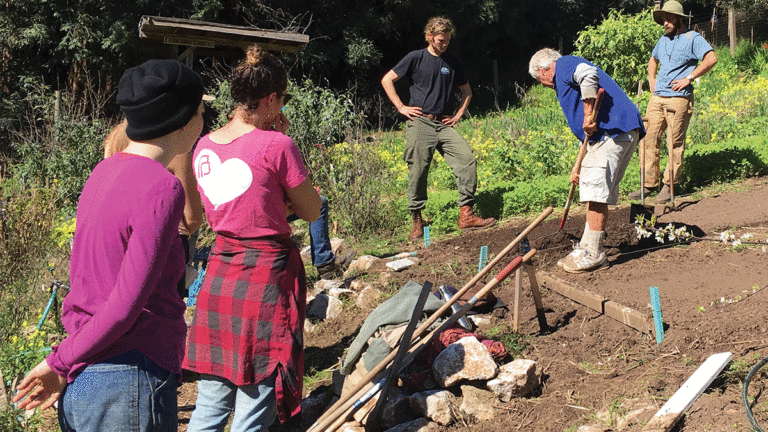Dee is 65 years old, and has lived on the streets of Santa Cruz for years. She doesn’t fit into the popular narrative of a Santa Cruz homeless population comprised of transients with hands out as they pass through, but she’s not interested in setting anyone straight. Nor does she want sympathy. She simply wants to be left alone.
“I don’t like being around that many people,” says Dee, who asked that her last name not be used. “It’s safer to be alone.”
However, Dee does rely on the assistance of her friends, particularly after she broke her hip in December, making mobility an issue. For the most part, Dee has braved the elements this winter without the benefit of shelter.
“I don’t have a problem with it,” she says. “I have a poncho, and I like the rain.”
But one night in February, the mercury was supposed to touch 33 degrees overnight, and combined with the rain and the pain in her hip, she knew she wouldn’t sleep.
“If you can’t sleep, you can’t function,” she says.
So she followed the advice of her friend Ernie Keller, another homeless resident of Santa Cruz, and headed to the Red Church—the nickname for the downtown Calvary Episcopal Church—where a makeshift shelter called the Warming Center has been established to react to such an event.
“I needed to be inside, and Ernie told me we could go to the Red Church,” Dee says. “They treated me very well.”
Keller has lived in Santa Cruz since 1955, when he was 10 years old. He has been homeless for years, ever since he developed vision problems and was declared legally blind, limiting his employment options.
He says Dee is his friend and he was glad he could help her out on a night that could have been dangerous.
Their stories are not uncommon in the homeless community, says Nancy Krusoe, a volunteer with the Warming Center Program.
“Santa Cruz is full of myths about homeless people,” Krusoe says. “There is a fear of homeless people, but they have so much more to fear than we do.”
Krusoe said her three-year stint as a volunteer has taught her more about class issues than all of her years teaching at UCSC.
“Contempt for poor people runs really deep,” she says. “It’s really hard to cross that line, to break that barrier.”
But breaking that barrier is exactly what the Warming Center hopes to do. Set to be honored at this week’s NEXTies as Nonprofit of the Year for its work in the community, the Warming Center was conceived and is run by Brent Adams, one of the most passionate homeless advocates in Santa Cruz.
Adams started the center three years ago after several homeless individuals died of exposure during a particularly brutal cold snap in the Bay Area.
“I realized we were not doing enough to help people who were dying outside,” Adams says.
Krusoe traces the origins of the Warming Center back to a planned protest camp set up outside the county building, which she says was cancelled at the eleventh hour when officials pulled the permit. After the initial disappointment, Adams and others turned their attention to more pragmatic fixes.
“Protests and protest camps weren’t an effective strategy, so we decided we needed a more hands-on approach,” he says.
Thus was born the Warming Center.
Leap of Faith
With no government funding, Adams relies on a crew of volunteers like Krusoe. The organization has forged deals with three churches—Calvary Episcopal, Peace United on High Street, and the Quaker Meeting House on Rooney Street—which provide floor space to host up to 100 people.
“We wanted to give people safe, dignified places to sleep,” Adams says.
The Warming Center also provides soup at night, and coffee, soup and pastries in the morning.
Blankets, coats, ponchos and other donated items are distributed to those who want them.
This winter was marked more by persistent rain than cold temperatures, but the Warming Center still opened for more than two dozen nights. They do so when overnight temperatures are below 35 degrees, or when overnight rain combines with temperatures that dip below 40 degrees.
While 25 nights may not seem like many over the course of a long winter, even those stretched the Warming Center’s $10,000 budget (a number which may have increased after the group raised money through GT’s Santa Cruz Gives program last year.) Gives Adams is careful not to overtax his team of volunteers, bringing them in for three-hour “bite-sized” shifts.
Krusoe and the other volunteers, meanwhile, marvel at Adams’ work ethic and dedication to the project.
“He doesn’t take any breaks,” she says.
Aside from managing the volunteers and their shifts, and picking up volunteers in his RV when they have to be shuttled to the churches on Rooney or High Street, Adams and his helpers also deliver fliers to members of the homeless community to alert them of imminent cold nights and urge them to make use of the Warming Center.
Another reason for the 25-night slate for the Warming Center is that its central purpose is to function as overflow for the county-funded winter shelter, which operates more consistently—every night after December 1.
That shelter is operated by the Association of Faith Communities of Santa Cruz County (AFC).
In the wake of this dramatic hit to the county’s homeless services, Santa Cruz County and the cities of Scotts Valley, Capitola and Santa Cruz came together to allocate about $360,000 for a homeless shelter to operate in the winter months. These are not pass-through dollars from the federal or state government; they come directly from local coffers.
After the public entities had trouble drawing organizations willing to undertake the program, the AFC stepped up.
“It was a leap of faith,” says Jon Showalter, board chair of the AFC.
But since taking on the Herculean task of marshaling 1,000 volunteers from across the spectrum of the faith community—including Catholics, protestants, evangelicals, Hindus, Buddhists and Jews—to stay open every night, Showalter is confident his organization will continue to progress in a more streamlined delivery of its services.
“It’s us and the Warming shelter keeping people from dying on the streets,” he says.
The AFC shelter operates out of the Veterans of Foreign Wars Hall on 7th Avenue in Live Oak and the Salvation Army building on Laurel Street. Both buildings, which have about a 100-person capacity, have been open every night throughout the winter.
The locations do present some challenges, as homeless residents must meet on the Felton side of the Tannery, meaning many of them must walk a mile to get picked up between the hours of 4 and 5:30 p.m. and shuttle to either location. They are then shuttled back the next day.
“I think the neighbors of the Salvation Army and the VFW don’t want a crowd congregating outside of their building, so we’ve landed on the shuttle as a solution,” Showalter says. “I understand it, but it comes with a cost.”
$50,000 to be exact, and it eats into the AFC’s already hamstrung budget, but Showalter says the organization is seeking ways to use the dollars it does have more efficiently. That will become particularly important as the county and cities meet to discuss the program’s future, which remains uncertain.
“The county has not made a decision about funding for next year,” says Rayne Marr, Santa Cruz County’s homeless services coordinator. “We don’t know who is going to operate it, or where or how. Nothing is set in stone, except that we want to have a winter shelter.”
Safety Network
For Keller, the trek to the Tannery is one reason he favors the Warming Center.
“I think I walked 40 miles in January,” says Keller, who is 71 years old, of attempting to use the county-funded shelters.
But Keller says there are other advantages to the Warming Center. There, you can come and go as you please, whereas the AFC shelters mandate that you arrive at the intake center during certain hours.
“We treat them like adults,” says Adams.
There are other subtle differences between the shelters. The Warming Center allows residents to keep belongings on hand; AFC insists they lock them up during their stay. The Warming Center lays out the sleeping pads and bedding and then collects them, the AFC asks guests to pitch in.
“We are trying to create an intentional community, and our expectation is the guest participate in the work of the shelter,” Showalter says. “Your self-worth plummets when nothing is expected of you except to get out of the way.”
Whatever their differences in approach, both homeless service organizations are aware of each other, and deeply appreciative of the other’s work.
Showalter and Adams also share something else in common—the awareness that their respective organizations are only a temporary Band-Aid, and that more is needed to confront the recurrent problem of homelessness in the county.
“We need to spend the money to get a year-round shelter,” says Showalter. “We need to focus on graduating these folks to permanent housing, because there is trauma to being on the street.”
Marr, the county’s homeless services coordinator, says the county is in active discussions with local cities about possible long-term solutions, which include exploring the viability of a year-round shelter.
“I think location is a big issue to resolve, and the other issue is funding,” Marr says.
Adams agrees that long-term solutions are vital. He favors the outdoor camp model undertaken in Eugene, Oregon, that features wooden platforms, tents, electronics recharging, showers and portable toilets. Adams encountered this sanctuary model in his work on a documentary about homelessness on the West Coast. He travelled to many different towns and cities throughout California, Oregon and Washington, interviewing various homeless people, nonprofit workers and government officials about their successes and failures in addressing homelessness in their communities.
One notion he found widespread was that improving homeless services only attracts more transients and crime, an idea he dismisses as shortsighted and callous.
“It’s a silly and small-minded thing to say,” Adams says. “Homelessness is mushrooming everywhere you go.”
While denial is dangerous, he says, real solutions can improve everyone’s quality of life.
“It’s better to provide dignifying places to sleep,” he says. “That way you give dignity to the whole community.”
More info at warmingcenterprogram.com.
The 2017 NEXTies
[dropcap]W[/dropcap]hen the NEXTies nomination committee got together to pick this year’s winners from more than 1,000 nominees, Event Santa Cruz’s Matthew Swinnerton opened the proceedings by declaring: “This is my favorite meeting of the year.”
Anyone who knows Swinnerton, who took over the NEXTies Awards in 2014, knows that’s saying something. The man is in a lot of meetings, and he tends to be extremely enthusiastic about them. But he says it was no exaggeration.
“I see the NEXTies as the Oscars of Event Santa Cruz,” he says. That means a chance to honor the up-and-coming local talent that he sees giving talks all year at Event Santa Cruz gatherings, and coming to hear those talks. Beginning last year, he added categories for the awards, which he has expanded this year.
“We did it, it worked, and now I’m just refining it,” he says, promising “more food, more music, more people, more beer” at this year’s awards ceremony, which is Friday, March 24 at the Rio. The show will be hosted by Danielle Crook and DNA. Musical guests will be the Coffis Brothers, Taylor Rae and McCoy Tyler. Food vendors will include My Mom’s Mole, Tanglewood, Artisan Hand Food, La Sofrita and more.
The NEXTies winners for 2017 are:
Entrepreneur of the Year: Sindy Hernandez de Cornejo
Musician of the Year: Taylor Rae
Band of the Year: The Coffis Brothers
Artist of the Year: Irene O’Connell
Writer of the Year: Lily Stoicheff
Give Back Person of the Year: Mariah Tanner & Natalie Anne Oliver
Foodie of the Year: Elizabeth Birnbaum
New Business of the Year: Cat & Cloud Coffee
Athlete of the Year: Ryan Navaroli
Under-18 person of the Year: Ashley Solis-Pavon, Community Agroecology Network
Nonprofit of the Year: Warming Project
Mentor of the Year: Keisha Frost
Innovative Business of the Year: Inboard
Innovator of the Year: Nick Halmos from Cityblooms
Techie of the Year: Gabriel Jesse Medina (From Digital NEST)
Green Business of the Year: Khordz Handmade Mugs
“Wildcard” Award: Happily Ever Laughter
Update 03/28/2017: It was originally reported that the Homeless Services Center shuttered its shelters in July 2015, but not that they re-opened two weeks later.
























